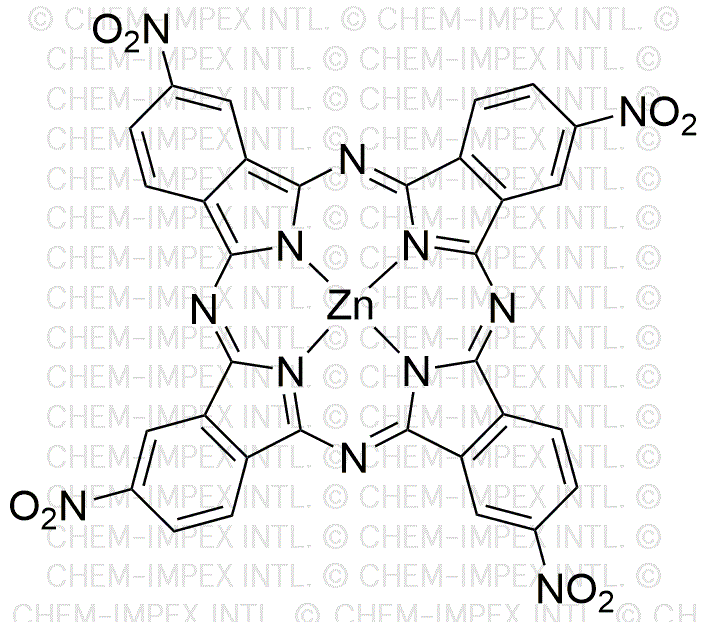Zinc(II) 2,9,16,23-(tetra-nitro)phthalocyanine is widely utilized in research focused on:
- Photodynamic Therapy: This compound is effective in treating certain cancers by generating reactive oxygen species when exposed to light, making it a promising agent in medical applications.
- Solar Energy Conversion: It plays a significant role in organic photovoltaic cells, enhancing light absorption and improving energy conversion efficiency, which is crucial for renewable energy technologies.
- Electrochemical Sensors: Its unique properties allow for the development of sensitive sensors for detecting pollutants and biomolecules, aiding environmental monitoring and health diagnostics.
- Colorants and Dyes: Used in various industries, it provides vibrant colors for plastics and textiles, offering stability and resistance to fading compared to traditional dyes.
- Nanotechnology: This compound is utilized in the synthesis of nanomaterials, which can be applied in drug delivery systems, enhancing the efficacy of pharmaceuticals.
General Information
Properties
Safety and Regulations
Applications
Zinc(II) 2,9,16,23-(tetra-nitro)phthalocyanine is widely utilized in research focused on:
- Photodynamic Therapy: This compound is effective in treating certain cancers by generating reactive oxygen species when exposed to light, making it a promising agent in medical applications.
- Solar Energy Conversion: It plays a significant role in organic photovoltaic cells, enhancing light absorption and improving energy conversion efficiency, which is crucial for renewable energy technologies.
- Electrochemical Sensors: Its unique properties allow for the development of sensitive sensors for detecting pollutants and biomolecules, aiding environmental monitoring and health diagnostics.
- Colorants and Dyes: Used in various industries, it provides vibrant colors for plastics and textiles, offering stability and resistance to fading compared to traditional dyes.
- Nanotechnology: This compound is utilized in the synthesis of nanomaterials, which can be applied in drug delivery systems, enhancing the efficacy of pharmaceuticals.
Documents
Safety Data Sheets (SDS)
The SDS provides comprehensive safety information on handling, storage, and disposal of the product.
Product Specification (PS)
The PS provides a comprehensive breakdown of the product’s properties, including chemical composition, physical state, purity, and storage requirements. It also details acceptable quality ranges and the product's intended applications.
Certificates of Analysis (COA)
Search for Certificates of Analysis (COA) by entering the products Lot Number. Lot and Batch Numbers can be found on a product’s label following the words ‘Lot’ or ‘Batch’.
*Catalog Number
*Lot Number
Certificates Of Origin (COO)
This COO confirms the country where the product was manufactured, and also details the materials and components used in it and whether it is derived from natural, synthetic, or other specific sources. This certificate may be required for customs, trade, and regulatory compliance.
*Catalog Number
*Lot Number
Safety Data Sheets (SDS)
The SDS provides comprehensive safety information on handling, storage, and disposal of the product.
DownloadProduct Specification (PS)
The PS provides a comprehensive breakdown of the product’s properties, including chemical composition, physical state, purity, and storage requirements. It also details acceptable quality ranges and the product's intended applications.
DownloadCertificates of Analysis (COA)
Search for Certificates of Analysis (COA) by entering the products Lot Number. Lot and Batch Numbers can be found on a product’s label following the words ‘Lot’ or ‘Batch’.
*Catalog Number
*Lot Number
Certificates Of Origin (COO)
This COO confirms the country where the product was manufactured, and also details the materials and components used in it and whether it is derived from natural, synthetic, or other specific sources. This certificate may be required for customs, trade, and regulatory compliance.


